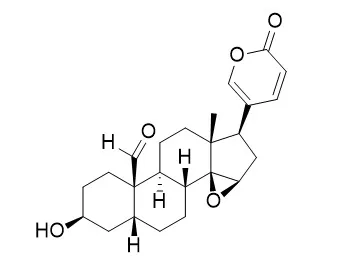To evaluate the inhibitory effect of total bufadienolides from toad venom against H22 tumor in mice and preliminarily analyze the structures of the metabolites in tissues.
METHODS AND RESULTS:
HPLC and LC-MS were used for analysis of the chemical composition of TBFs. High, middle and low dosages of TBFs were orally administered or intra-peritoneally injected to H22 tumor-bearing mice for thirteen days. The animals were killed and the tumors were stripped and weighed. The metabolites in the tissues such as heart, liver, spleen, lung and kidney, were analyzed by HPLC and LC-MS. The chemical composition of TBFs were identified by comparison of the retention times with those of reference substances, on-line UV spectra and MS data. Its main components are concerned with gamabufotalin, arenobufagin, bufotalin, Resibufagin, cinobufotalin, bufalin, cinobufagin and resibufogenin. TBFs had no obvious influence on body weight of H-22 tumor-bearing mice orally administered and the inhibition rate against tumor were 14.76%, 16.38% and 10.32% for low (5 mg x kg(-1)), middle (10 mg x kg(-1)) and high dosage (20 mg x kg(-1)), respectively. The mice intra-peritoneally injected with middle and high-dose of TBFs gained body weight slower than the control mice on the 5th day and recovered on the 13th day. The inhibition rate against tumor were 17.30%, 19.80% and 40.95% for low (1.5 mg x kg(-1)), middle (3 mg x kg(-1)) and high dose (6 mg x kg(-1)), respectively. The inhibitory effect took on dose-dependent manner. Based on the HPLC analyses on heart, liver, spleen, lung and kidney, bufadienolides were found in the liver tissue and 11 compounds of them were tentatively identified by LC-DAD-MS.
CONCLUSIONS:
TBFs by oral administration had no inhibitory effect against H22 tumor in mice, however, TBFs by intra-peritoneal injection displayed the significantly inhibitory effect, accompanying some toxicity for early duration of the study. The identification of bufadienolides in the liver provides a good basis for the further investigation of the metabolic pathways of TBFs in vivo. |






 Cell. 2018 Jan 11;172(1-2):249-261.e12. doi: 10.1016/j.cell.2017.12.019.IF=36.216(2019)
Cell. 2018 Jan 11;172(1-2):249-261.e12. doi: 10.1016/j.cell.2017.12.019.IF=36.216(2019) Cell Metab. 2020 Mar 3;31(3):534-548.e5. doi: 10.1016/j.cmet.2020.01.002.IF=22.415(2019)
Cell Metab. 2020 Mar 3;31(3):534-548.e5. doi: 10.1016/j.cmet.2020.01.002.IF=22.415(2019) Mol Cell. 2017 Nov 16;68(4):673-685.e6. doi: 10.1016/j.molcel.2017.10.022.IF=14.548(2019)
Mol Cell. 2017 Nov 16;68(4):673-685.e6. doi: 10.1016/j.molcel.2017.10.022.IF=14.548(2019)